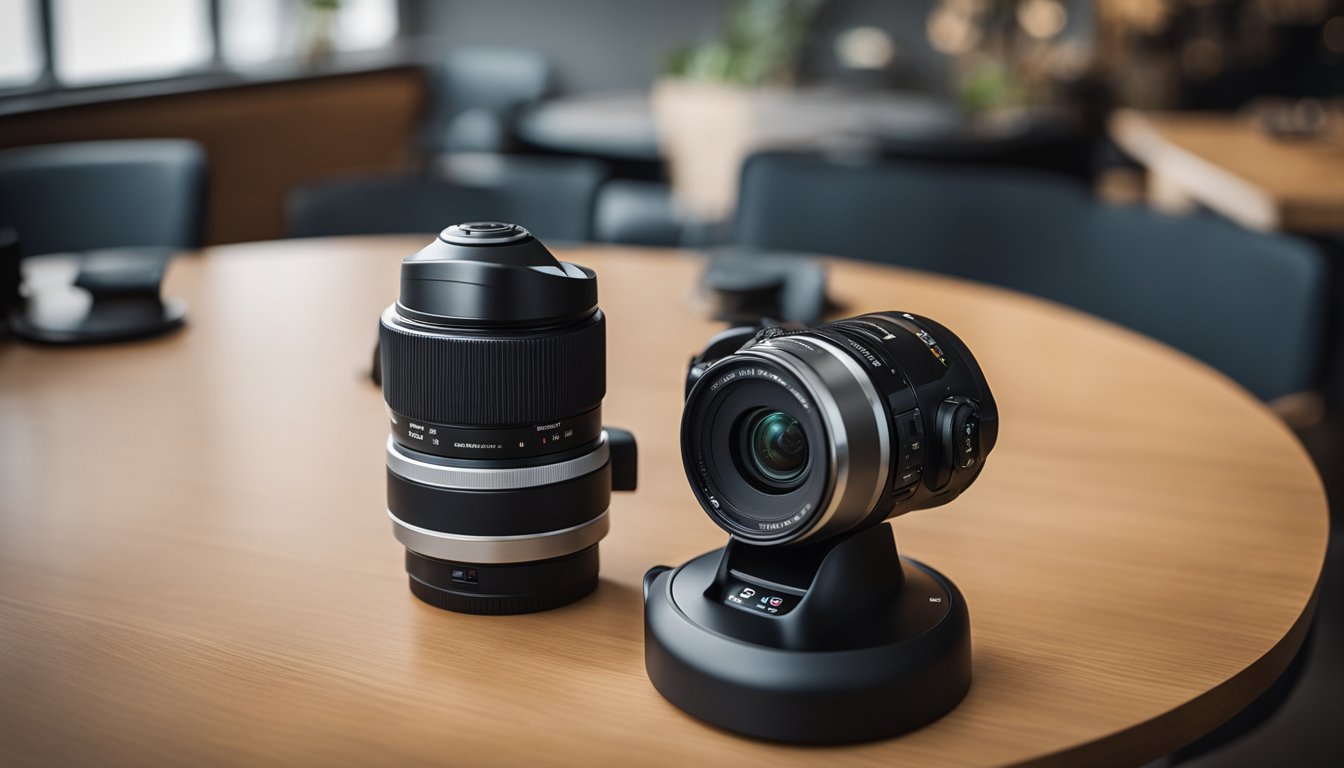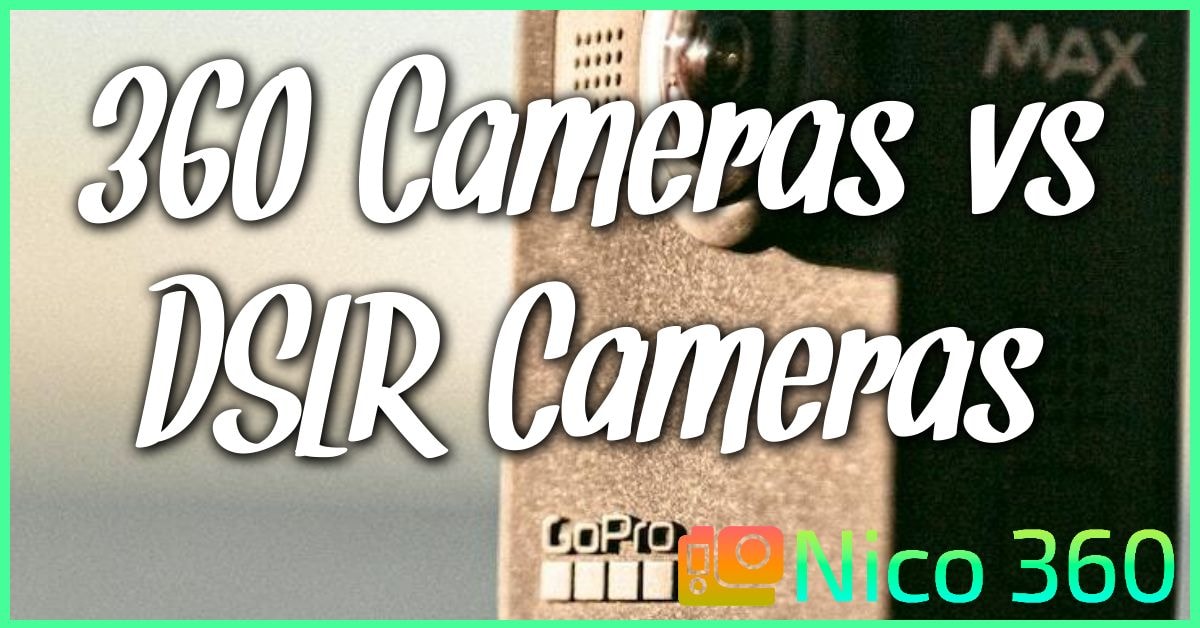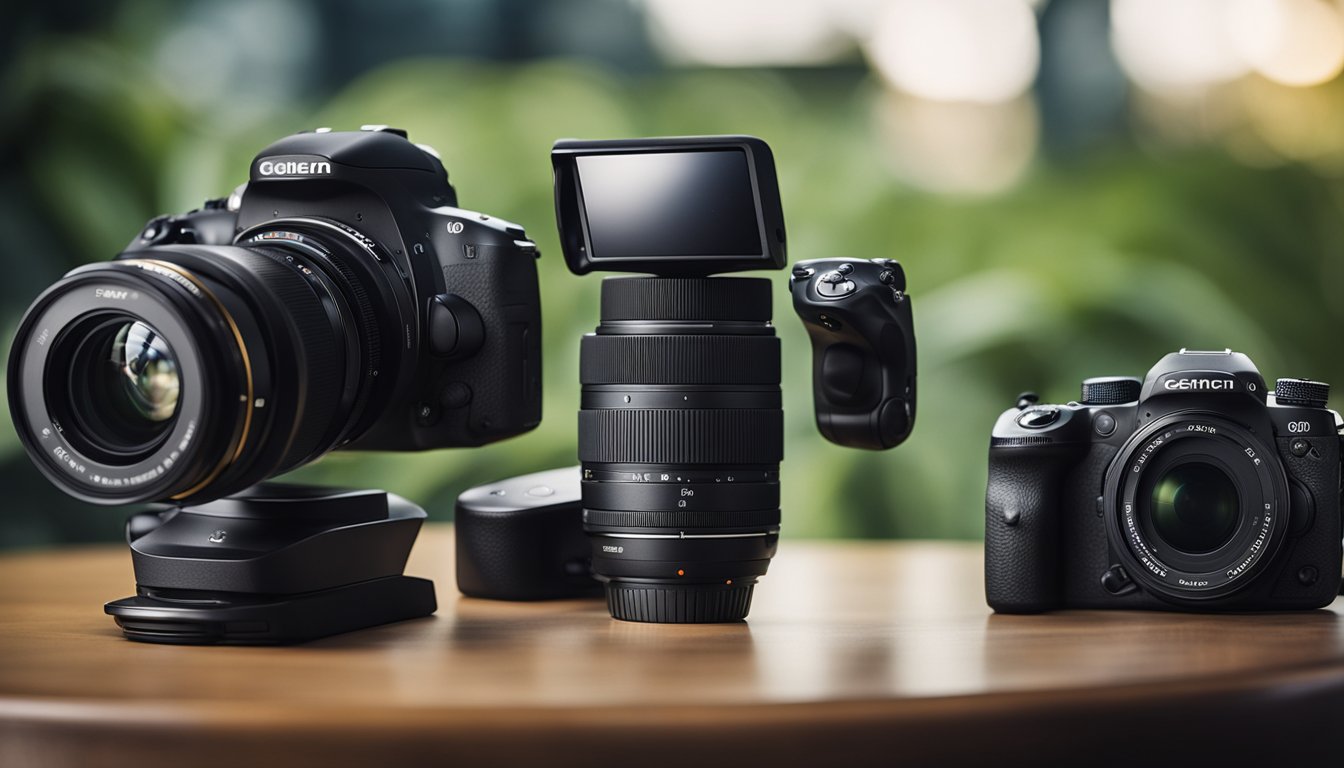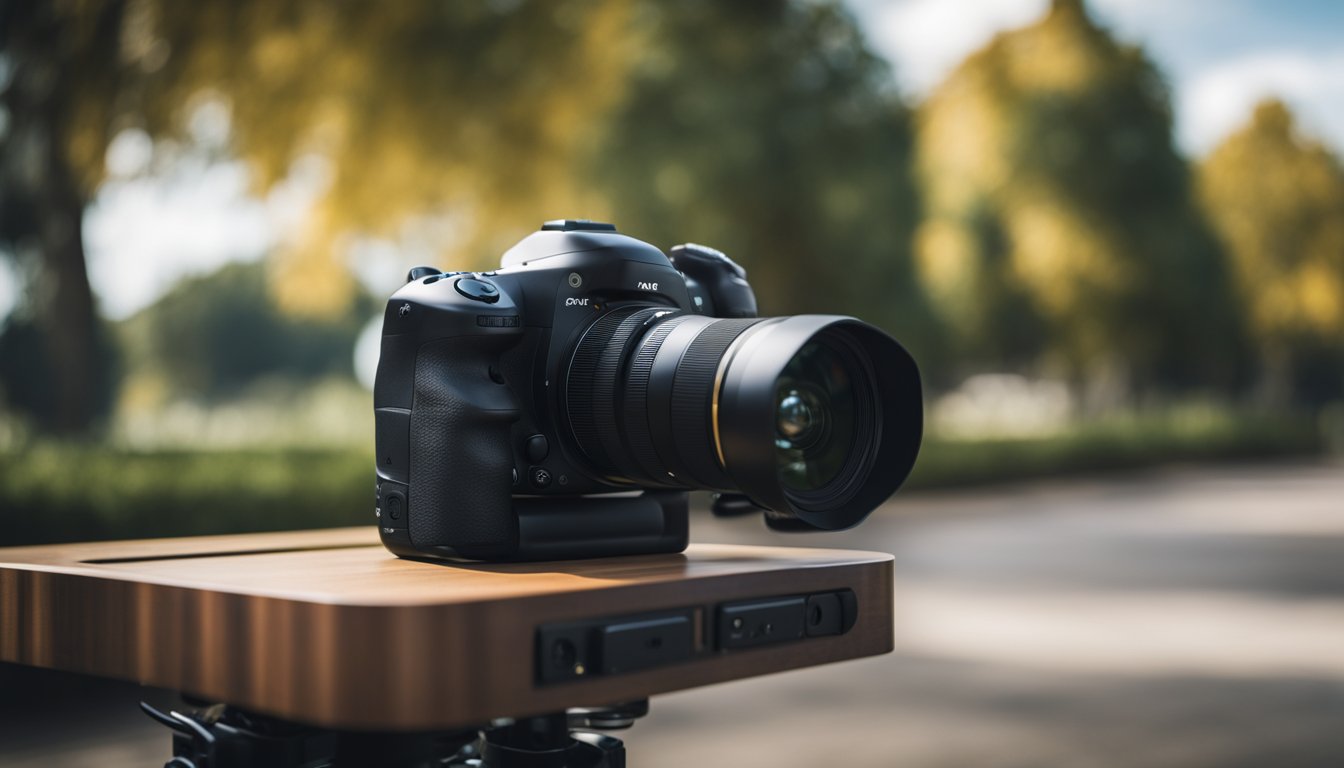When it comes to capturing high-quality images, the choice between a 360 camera and a DSLR is one that photographers of all skill levels might grapple with. While traditional DSLRs offer high-resolution images and the flexibility of interchangeable lenses for various photographic challenges, 360 cameras bring a new dimension to photography by capturing a full spherical image in one shot. These innovative devices are particularly useful in creating virtual tours or capturing immersive environments where every angle is essential.

Choosing between a 360 camera and a DSLR depends on what you’re looking to achieve with your photography. DSLRs are known for their superior image quality and resolution, control over depth of field, and a vast array of lens options that can define your shot. On the other hand, 360 cameras offer unparalleled field of view with simple, compact designs that make capturing and sharing your entire environment easy. While DSLRs can be complex and often require post-processing for the best results, 360 cameras simplify the capture process, which can be advantageous for those with less technical expertise.
Connectivity is another key difference, as many 360 cameras have built-in sharing features compatible with social media platforms that support 360 content. In contrast, DSLRs might require additional hardware and software to transfer and edit images. When considering which type of camera to use, factors such as use case scenarios, your budget, and the desired end product are paramount to making the right decision. The emergence of new features and capabilities continually shapes how both 360 cameras and DSLRs evolve, alongside the ecosystems of hardware and software that support them.
Key Takeaways
- Both 360 cameras and DSLRs have unique advantages, but the best choice depends on your specific photography needs.
- DSLRs offer higher image resolution and versatility with lenses, while 360 cameras shine in ease of use and creating immersive content.
- Consider the intended use, cost, ease of sharing content, and available features to determine which camera suits your purposes best.
Understanding Camera Types
When you’re deciding between a 360 camera and a DSLR, it’s crucial to understand their core features and capabilities. This section will guide you through what each type offers and how they compare.
Definitions and Differences
- 360 Cameras: Utilize lenses on front and back to capture full 360-degree images or footage, often in a single shot.
- DSLR Cameras: Feature a single lens and a reflex mirror that allows you to see directly through the lens via the viewfinder.
360 cameras provide a spherical view of the environment, which is essential for virtual tours or immersive experiences. In contrast, DSLRs offer high-quality images with more control over composition due to their manual settings and interchangeable lenses.
360 Camera Basics
360 cameras typically come equipped with two ultra-wide fisheye lenses to capture a full spherical image. They’re excellent for creating interactive views, allowing the viewer to look in any direction. Content from these cameras is often used in virtual reality applications or panoramic photography.
Key features:

- Two fisheye lenses
- Full 360-degree coverage
- Ease of use for panoramic content
DSLR Camera Fundamentals
DSLR (Digital Single-Lens Reflex) cameras are the digital evolution of the traditional SLR (Single-Lens Reflex) camera. They use interchangeable lenses and a mirror and prism system that lets you see the exact image you’re capturing through the optical viewfinder.
Characteristics:
- Interchangeable lenses for various photographic needs
- Optical viewfinder for a through-the-lens perspective
- Typically larger and offer more manual control than mirrorless cameras
DSLRs favor photographers who want complete control over every shot. They are versatile for nearly any type of photography, from portraits to landscapes.
Image Quality and Resolution
When you dive into the worlds of 360 cameras and DSLRs, you’ll notice that image quality and resolution are key factors that distinguish these two types of cameras. Your experience in capturing vast scenes or intricate details is hugely impacted by these aspects.
360 Camera Resolution
360 cameras are designed to capture entire environments in one go, wrapping the scene around you in a full sphere. Modern 360 cameras offer resolutions that can go up to 8K, which translates to crisp and immersive panoramas. For example, a camera boasting a 5.7K resolution can provide you with a satisfactory level of detail for both virtual reality experiences and standard video playback. Remember, though, the resolution is split over the entire 360-degree image, affecting how fine the details will appear when you zoom in.
DSLR Image Detail
In contrast, DSLRs stand strong in the arena of image detail. Equipped with larger sensors and higher resolution, DSLRs can capture images with fine detail and dynamic range, essential for producing professional-quality photos. A DSLR might offer a similar numerical resolution compared to a 360 camera, but thanks to the larger sensor size, the quality of each pixel is typically superior, resulting in clearer and more detailed images. Understanding this key difference is essential when meticulous detail and texture are your top priority.
Lenses and Field of View
« How to Install a 360 Camera in a Car: A Step-by-Step Guide
360 Camera with Lidar: The Future of Capturing Immersive Environments »
When you’re choosing between a 360 camera and a DSLR, understanding the differences in lenses and field of view is crucial. Here, you’ll discover how these aspects influence your photography and virtual tour experiences.
Fisheye and Wide-Angle Lenses
360 cameras typically come with fisheye lenses, which have an extremely wide field of view. These lenses allow you to capture a full 360-degree scene in a single shot. Owing to their unique properties, fisheye lenses give a distinctive spherical view that’s key for immersive panoramas and virtual tours. Unlike traditional lenses, the field of view with fisheye lenses spans beyond the typical 180 degrees, allowing for a full wraparound effect, which is a significant advantage for 360 photography, as suggested by 360 Cameras vs DSLR Cameras.
Interchangeable Lenses for DSLRs
On the other hand, DSLRs are equipped with interchangeable lenses, letting you switch between different types of lenses, including wide-angle lenses. While wide-angle lenses can capture a broad scene, they’re not as expansive as fisheye lenses. You’ll find that wide-angles typically have a field of view ranging from about 64 to 84 degrees, which is great for landscape shots, but they don’t wrap around to form a 360-degree view. This characteristic is what sets apart DSLRs when it comes to versatility in photography. The ability to choose your lens as per the need can profoundly impact the visual outcome of your images, highlighted in the comparisons at 360 camera vs. DSLR.
Camera Performance Factors
When choosing between 360 cameras and DSLR cameras, two pivotal aspects affecting your image quality are sensor size and dynamic range. These factors can profoundly influence how your photos turn out, especially in challenging lighting conditions.
Sensor Size
360 cameras often employ smaller sensors due to their compact design which allows for dual-lens capture to stitch together a 360-degree image. Conversely, DSLR cameras typically have larger sensors, with sizes ranging from APS-C to full frame. The larger the sensor, the greater the capacity to capture light, which can lead to better image quality and enhanced performance in low-light situations.
- 360 Cameras: Generally have smaller sensors
- DSLR Cameras: Range from APS-C to full frame sensors
Dynamic Range Explained
Dynamic range refers to the camera’s ability to capture the breadth of tonal details from the darkest shadows to the brightest highlights. A higher dynamic range can yield photos with more detail in high-contrast scenes. DSLR cameras, particularly those with full frame sensors, tend to have a better dynamic range when compared to 360 cameras. This means in scenes with extreme contrasts, such as sunsets or concerts, you’re more likely to retain details without losing them to overexposed highlights or underexposed shadows.
- 360 Cameras: May have a more limited dynamic range
- DSLR Cameras: Often feature a higher dynamic range, especially in full frame models
Use Cases and Settings

When you’re choosing between a 360 camera and a DSLR, consider your primary use case. Whether you’re creating immersive virtual tours or capturing high-quality stills, each type of camera excels in different scenarios and settings.
360 Cameras in Virtual Tours
360 cameras offer a unique advantage in creating virtual tours. With their ability to capture a full spherical view of a scene, you’re able to provide a seamless experience. Imagine being able to showcase a bedroom in a real estate listing where viewers can look around as if they’re standing in the middle of the room. This capability is not just impressive for viewers but also efficient for photographers; it often takes a single shot to capture the entire ambiance of a location.
DSLRs in Professional Photography
For professional photography, DSLRs are hard to beat. Their larger sensors allow for superior image quality, especially in low-light conditions. Your photography can benefit from a DSLR’s depth of field and crisp detail when capturing still scenes or live subjects. When it comes to live stream events, although some DSLRs offer this functionality, they might require additional setup compared to 360 cameras, which are generally more plug-and-play for live streaming.
Price and Cost Considerations
When you’re deciding between a 360 camera and a DSLR, understanding the financial implications is crucial. Not only the upfront cost but also the long-term investment matters for your photography or videography needs.
Initial Investment
360 cameras provide a range of options, suitable for various budgets. You can find models best for entry-level users that start as low as $200 and meet basic needs for virtual tours or video content. On the other hand, high-end 360 cameras, as described in this comparison of 360 cameras, offer more advanced features and higher quality output but come at a steeper price. Very top-of-the-line models can even cost thousands. In contrast, DSLRs require a significant initial investment, often exceeding the cost of mid-tier 360 cameras, especially when factoring in lenses and accessories needed to create 360 photos.
Maintenance and Upgrades
Once you’ve made your purchase, the long-term costs associated with maintenance and upgrades come into play. 360 cameras tend to have fewer moving parts and may incur lower maintenance costs. Moreover, the upgrade path can be more straightforward with all-in-one units. DSLR cameras may require ongoing investment in new lenses, maintenance for mechanical parts, or even upgrading to newer models to keep up with technology advancements. While a 360 camera might need fewer accessories, the cost of updating to the latest model for enhanced features could still be considerable.
Ease of Use and Accessibility
When considering 360 cameras versus DSLR cameras, you’ll find that user-friendly features and ease of access play pivotal roles. Not only do these aspects affect how you shoot photos but also the post-processing work you’ll need to do.
User-Friendly Features and Interfaces
360 cameras often come with intuitive interfaces and user-friendly features that benefit quick learning and operation. They are designed with simplicity in mind, integrating one-shot capabilities where you can capture an entire scene in a single click. This is particularly handy when you’re in a rush or capturing moments that you don’t want to miss. Many 360 cameras also include a self-timer feature, giving you the time to set up and become part of the shot.
- Fisheye lenses: Allow capture of wide fields with simple operation.
- Single shot: Reduces complexity in capturing expansive scenes.
- Self-timer: Offers convenience when trying to be in the photo.
Post-Processing and Editing Demands
The ease of use extends to post-processing as well. Most 360 cameras are equipped with software that automates stitching and other editing tasks, reducing the editing demands on you. While DSLR cameras might provide high-quality images and more control over the final output, they often require substantial time investment in learning and applying post-processing techniques. Many 360 cameras come with tutorials and user-support materials that can help you navigate through this post-shooting stage more comfortably.
- Automated stitching: Simplifies the editing process.
- Editing tutorials: Assists in learning software features quickly.
By keeping the user interface straightforward and reducing the complexity of post-shooting edits, 360 cameras prove to be accessible and practical for both beginners and seasoned photographers looking for a swift shooting experience.
Camera Connectivity
In the realm of modern photography, the manner in which you connect your camera to other devices and services can greatly enhance your experience. Wi-Fi and GPS are built into many cameras, offering easy sharing and geotagging options.
Wi-Fi and GPS Features
Most 360 cameras come with integrated Wi-Fi, allowing you to connect directly to your smartphone or tablet for immediate photo sharing. This wireless connectivity typically enables remote camera control as well, so you can capture shots from a distance. Additionally, the GPS feature in some 360 cameras stamps your photos with location data, which can be fantastic for mapping your photo expeditions or creating travel blogs.
In comparison, DSLR cameras have started incorporating Wi-Fi and GPS, but these features might not be as seamlessly integrated as in 360 cameras. For instance, some DSLR models might require an external GPS unit for location tagging or may not support remote shooting over Wi-Fi without additional accessories.
Software and Sharing Options
With software that compliments your 360 camera, you can stitch images together, edit them and share them directly to social media or cloud storage. These tools often have user-friendly interfaces that make it simple for you to handle complex editing tasks.
DSLRs, on the other hand, tend to rely on more professional software solutions for photo editing. While powerful, they can have a steeper learning curve. For sharing, once your photos are ready, Wi-Fi capabilities in your DSLR allow you to upload images to various platforms, though you may find the process less direct than with 360 cameras.
Innovative Features and Capabilities

When you’re exploring the differences between 360 cameras and DSLR cameras, you’ll find that innovation in camera technology has pushed both types into exciting new territories. Features like modular designs and advanced photography modes are shaping the future of how you capture and experience images.
Modular Cameras
With a modular design, cameras like the Insta360 One R have revolutionized personal photography. You have the flexibility to swap out lens modules, turning your 360 camera into a traditional action cam or even a 3D camera. This adaptability means you get a multi-purpose device that caters to a wide variety of shooting scenarios.
HDR and 3D Photography
Capturing images with High Dynamic Range (HDR) has become a staple among modern cameras, providing you with photos that better represent the range of light and dark in a scene. Many 360 cameras also offer HDR, adding to the depth and realism of your shots. The QooCam 8K, for instance, is equipped to deliver high-quality HDR photographs. Meanwhile, advances in 3D photography are allowing both 360 and DSLR cameras to create more immersive visuals that make your photos feel like they’re popping out of the screen.
Hardware and Software Ecosystem
When you’re looking into 360 cameras or DSLRs, the range of accessories and software compatibility can deeply influence your experience. Whether it’s for leisure or professional use, understanding what’s available for hardware expansion and how these cameras interface with other devices is crucial.
Available Accessories
For 360 cameras, the availability of accessories may be more limited compared to DSLRs, but the ones that do exist are highly specialized. You’ll find:
- Mounts and stands specifically designed for 360-degree capture,
- Underwater housing to protect your camera during aquatic adventures,
- Proprietary stitching software that helps seamlessly merge your footage into a single spherical image.
DSLRs, on the other hand, have a vast ecosystem that includes:
- An extensive variety of lenses for every scenario,
- External flashes and lighting rigs for precise lighting control,
- Battery grips for extended shooting sessions, and
- A multitude of maintenance kits to keep your camera in top condition.
Compatibility with Drones and Action Cams
When it comes to drones, most high-end consumer drones are designed to be compatible with action cams or have built-in 360 cameras. However, if you’re using a DSLR:
- You’ll need a drone capable of carrying heavier payloads,
- Ensure it has a gimbal system for stabilization,
- Be aware that you might require specialized software to control the DSLR from the ground.
On the action cam front, 360 cameras double up as action cams due to their compact size and rugged build. Plus, many have modular designs, allowing you to strip them down for lightweight action footage or build them up for 360-degree shooting.
Brand and Model Comparisons
When looking into the best camera for your needs, brand and model specifics are crucial. In the realm of 360 cameras and DSLRs, there are notable models that stand out for their performance and features. Let’s take a closer look.
Popular 360 Camera Choices
-
GoPro MAX: Noted for its rugged design and ability to capture immersive 360-degree footage, the GoPro MAX is a favorite among action enthusiasts. Thanks to its user-friendly interface, you can produce stunning video and stills, even underwater.
-
Insta360 ONE X: This model is renowned for its high-quality output and compact size, making it an excellent choice for capturing life on the go. The Insta360 ONE X offers a blend of convenience and quality, with features like 5.7K video resolution and FlowState stabilization.
-
Theta Z1: For those who prioritize image quality, the Theta Z1 boasts a one-inch sensor and the ability to shoot in RAW, setting a high standard for 360 camera imagery in its category.
Top DSLR Picks
-
Sony A7R III: Renowned for its impressive resolution, the Sony A7R III combines a 42.4 MP sensor with fast autofocus. It’s a stellar choice for photographers needing high-resolution images and top-tier performance in a full-frame format.
-
Nikon D850: Recognized for its versatility, the Nikon D850 features high resolution, excellent dynamic range, and speed. Whether it’s landscape, portraiture, or wildlife photography, this DSLR is up for the challenge.
-
Canon EOS 5D Mark IV: A well-rounded professional favorite, the Canon EOS 5D Mark IV offers a 30.4 MP sensor and 4K video capability. Its reliable performance makes it a go-to DSLR for serious photographers worldwide.
Frequently Asked Questions
Navigating through the nuances of 360 and DSLR cameras can be confusing. In this section, you’ll find clear answers to some common questions to guide your understanding and help you make the right choice for your photography needs.
What are the pros and cons of 360 cameras compared to traditional DSLRs?
360 cameras offer the ability to capture images in a full spherical view, which is ideal for immersive experiences and virtual tours. Their small size and ease of use are also advantages. In contrast, DSLRs boast superior image quality, manual controls, and a vast selection of lenses for different situations. Learn more about the advantages and limitations of 360 cameras.
Can 360 cameras be used for professional photography like DSLRs?
While 360 cameras have started finding their place in professional settings, particularly for interactive content and virtual reality, DSLRs remain the mainstay for traditional professional photography due to their high image quality, versatility, and control.
How do 360 cameras perform for capturing virtual tours versus DSLRs?
360 cameras excel in creating virtual tours, as they can capture an entire scene in a single shot, making the process simpler and faster. DSLRs, however, require multiple shots to create a panorama and may offer higher resolution and image quality. Discover the equipment comparison for shooting virtual tours.
What makes DSLRs a better choice than 360 cameras for certain photography styles?
DSLRs offer better image quality, control over depth of field, and the ability to use various lenses, which makes them a preferred choice for portrait, landscape, and sports photography where detail and control are crucial.
Are there affordable 360 camera options that compete with DSLR cameras?
There are indeed cost-effective 360 cameras available that provide a good balance between price and performance. While they might not offer the same level of image quality as DSLRs, they are a more accessible option for capturing 360-degree content.
How do 360 cameras and DSLRs differ when it comes to vlogging?
For vloggers, 360 cameras offer a unique and engaging perspective, allowing viewers to experience the environment in a more interactive way. DSLR cameras provide higher video quality and creative control, which may be more suitable for traditional vlogging styles.





